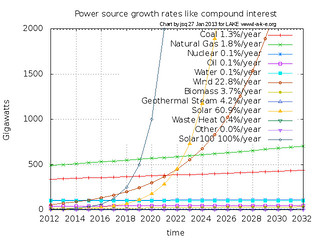If new nukes make no sense because of natural gas prices, they make even less sense with continually-dropping solar power prices.
Ray Henry wrote for AP yesterday, Regulator: New nuke plant now wouldn’t make sense,
If Georgia was starting from scratch, it would not build a nuclear power plant….
An analyst working for state regulators, Philip Hayet, said in written testimony that the total costs of building two more nuclear reactors at Plant Vogtle (VOH’-gohl) is more expensive than the next-best option, constructing natural gas plants.
Still, Hayet said it is cheaper in most scenarios to finish the nuclear plant rather than halt the project and instead build natural gas plants.
But it’s not cheaper to finish a nuke than to halt it and get on with wind offshore and distributed solar power throughout Georgia.
GA PSC didn’t publish Hayet’s calculations, using the old excuse of “they involve proprietary financial information from Southern Co. subsidiary Georgia Power”. But Edison Electric Institute didn’t need any proprietary financial information to compute that distributed solar power is already disrupting the century-old baseload business model that has been used to justify nukes new or old. We don’t need any proprietary information to see that Moore’s Law for solar is pushing prices down and deployments up like compound interest. From EEI’s January 2013 report:
Bloomberg New Energy Finance (BNEF) projects that distributed solar capacity will grow rapidly as a result of the competitive dynamics highlighted. BNEF projects 22-percent compound annual growth in PV installations through 2020, resulting in 30 gigawatts (GW) of capacity overall (and approximately 4.5 GW coming from distributed PV). This would account for 10 percent of capacity in key markets coming from distributed resources and even a larger share of year-round energy generated.
 And BNEF’s numbers are actually low according to
FERC’s figures
on actual installed capacity in 2011 and 2012
for each power source in the U.S.
FERC’s figures show 60.9% compound annual growth rate for solar
and 22.8% for wind, with nothing else anywhere close:
not natural gas, not coal with plants closing, and certainly not nuclear.
Projecting FERC’s figures out a few years, solar passes coal in about 8 years,
wind in about 9, and natural gas in about a decade.
That’s for total amount of installed capacity.
And BNEF’s numbers are actually low according to
FERC’s figures
on actual installed capacity in 2011 and 2012
for each power source in the U.S.
FERC’s figures show 60.9% compound annual growth rate for solar
and 22.8% for wind, with nothing else anywhere close:
not natural gas, not coal with plants closing, and certainly not nuclear.
Projecting FERC’s figures out a few years, solar passes coal in about 8 years,
wind in about 9, and natural gas in about a decade.
That’s for total amount of installed capacity.
Georgia can continue to
lag behind small northern states like New Jersey,
 or Georgia Power and Southern Company
can help Georgia lead the southeast
and the world in solar and wind power.
GA PSC can help them make that right choice:
right for the environment, right for jobs and energy independence for Georgians,
right for the ratepayers and taxpayers of Georgia,
and right for the bottom line of Georgia Power and Southern Company.
or Georgia Power and Southern Company
can help Georgia lead the southeast
and the world in solar and wind power.
GA PSC can help them make that right choice:
right for the environment, right for jobs and energy independence for Georgians,
right for the ratepayers and taxpayers of Georgia,
and right for the bottom line of Georgia Power and Southern Company.
-jsq
Short Link:
Pingback: Last NRC call about foreign ownership of U.S. nuclear reactors: now until noon today | On the LAKE front
Pingback: Entergy shutting down Vermont Yankee nuke: tenth down or never to be built in past year | On the LAKE front